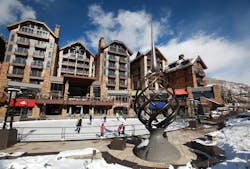What You Need to Know About Snow and Ice Melting Systems
Snow and ice can wreak havoc on your building this time of year. When plowing, salting and shoveling just aren’t cutting it or are blowing past your budget, consider what it would take to install a hydronic snow and ice melting (SIM) system outside your facility.
(Photo: REHAU RAUPEX pipe is fastened to rebar in a pool deck at Banff Upper Hot Springs, located in the Canadian Rockies. Credit: REHAU)
“If you have a lot of foot traffic and you want to bring your maintenance down and not risk people falling, it’s a great way to keep everything snow- and ice-free,” says Corrie Neukirchner, marketing director for the building solutions division of REHAU, a polymer manufacturer that offers piping for SIM systems.
The Benefits
- SIM systems are becoming increasingly popular in commercial settings and are often installed for walkways, stairs, sidewalks and parking structures to improve safety and eliminate liabilities where people walk and drive.
- REHAU is currently involved with a mixed-use building – with retail and restaurants on the ground floor and apartments above – in downtown Denver. The plaza and main entrances use a SIM system. “The owner of the building recognizes that this is a big selling feature for the residents who are going to be coming in and out and to those storefronts,” says Mike East, account manager for REHAU.
- When well-designed, a SIM system can eliminate hassle of organizing and scheduling snow removal and the risk of staff injuries.
- It protects outdoor surfaces from the wear and tear of salting, chemical deicers and associated equipment.
What Does Cost Look Like?
Facilities managers can pay upwards of tens of thousands of dollars per year for the labor, equipment and supplies needed for snow removal, according to the Modern Hydronics Summit. Installing a SIM system could reduce that annual cost.
[Read also: Where Resilience and Energy Efficiency Intersect]
For a SIM system, the actual piping that would run throughout your desired outdoor surface is inexpensive. The biggest cost will likely be the source of the warmed fluid, such as a boiler. However, many commercial buildings already have enough extra boiler capacity to power a SIM system, according to REHAU.
Because the weather can be difficult to predict, it’s also difficult to predict the operating costs of SIM systems with any certainty. But estimations can be made based on historical weather data and current fuel costs.
For more information, REHAU lists a few case studies online that include the size of the project, the location, the heat source, the cost of natural gas, the typical temperature at the start of snowfall and more.
Types of Installation
Common types of surfaces where SIM systems are installed include:
- Poured concrete: The tubing is often stapled directly to the insulation board underneath or is tied to some kind of fixing rail or rebar. Tubing is usually embedded two to three inches from the top of the surface.
- Interlocking pavers: Tubing is embedded inside the sand bed that’s laid underneath pavers (with a layer of insulation underneath that). Screw clips or staples are used to hold the tubing in place.
- Asphalt: The installation is similar to interlocking pavers, although stone dust is used instead of sand.
Help BUILDINGS Shape 2019!
What BUILDINGS resources are most valuable to you? What would you like to see us provide?
Please take our short (under 2 minutes) survey - just 5 short questions.
Thank you!
Tips for Installing a SIM System
If you feel that installing a SIM system will improve your facility and its operations, Neukirchner and REHAU say you should consider these tips beforehand:
- SIM systems are ideal when replacing or constructing an outdoor surface. Neukirchner recommends facilities managers think about a SIM system as soon as they consider their outdoor projects.
- Identify the heat source in relation to your snow and ice melting application.
- Identify where the heat source is physically located relative to the SIM area.
- One manifold can serve 1,500 square feet of SIM area.
- The geometry of the outdoor space will impact the requirements of the SIM design.
In the commercial setting, a SIM system has proven to be an amenity that draws tenants. It’s also a way to simplify your snow removal operations and improve the lifespan of your outdoor surfaces. Consider if it’s right for your facility – and stave off winter weather havoc.
Two handpicked articles to read next:
About the Author

Sarah Kloepple
Associate Editor
Sarah joined the BUILDINGS team as an associate editor in August 2018. She is a graduate of the Missouri School of Journalism, where her focus was magazine writing. She's written and edited for numerous publications in her hometown of St. Louis.

